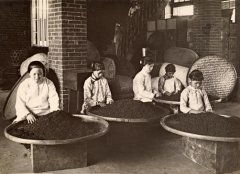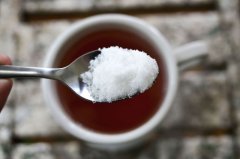Indian Milk Tea Massala Tea benefits and production process Teaching Indian Tea Brewing skills
Indian milk tea is called "Indian Milk Tea". This kind of milk tea is regarded as a kind of Indian cuisine in Britain and belongs to two different neighborhoods from British milk tea.
It is said that almost all Indians drink several cups of milk tea every day, and the tea used to brew Indian milk tea is FANNINGS (broken tea with a size of about 1mm) and CTC tea, which are among the highest in the world.
The way of brewing milk tea in North India is different from that in South India. North Indians are used to pouring water into a pot with black tea, adding spices such as ginger, cardamom and black pepper, and then using a fierce fire to force out the taste of black tea. After boiling, add a lot of sugar and raw milk to stew.
In India, whether in shops or roadside stalls on the side of the street, Indian milk tea can be seen everywhere, even within reach.
South India will put the tea into a cloth filter and pour hot water from the top to extract the black tea. Then pour the black tea into the mug with the handle, then pour in the sugar, spices and boiling milk, stir with a spoon and then pull the tea, that is, pour the milk tea from the high mug into the lower mug, back and forth several times, and finally pour it into a glass or ceramic cup.

From this point of view, whether in North India or South India, the local black tea is very sweet, tastes like dessert, and the addition of spices also helps to restore strength.
Milk used in Indian milk tea
Indian milk tea is so mellow and sweet that many people think it is boiled only with milk and jar tea, but in fact, water is added in order to fully extract the taste of black tea.
The milk used in Indian milk tea is unpasteurized raw milk and cannot be drunk directly. In addition, when the tea is mixed with milk, the milk fat will prevent the tea from absorbing water, making it difficult to extract the taste of black tea.

Therefore, the tea leaves must be boiled with a little water in the pot and then poured into the raw milk. the taste of raw milk is particularly refreshing and light, accounting for 60% of the total milk tea in India. It is precisely because of the large amount of milk that makes the Indian milk tea mouth look like there is no water.
When making Indian milk tea, even if you use commercial ultra-high temperature milk or low temperature pasteurized milk, you must first boil the tea with a little water, then take out the taste of black tea, and then pour in the milk in order to show a solid sense of black tea.
Commercial milk is thicker than raw milk, so when it is used to make Indian milk tea, the amount of water can be used a little more. The recommended ratio is "Water: milk = 4Rd 6J."
Spices used in Indian milk tea
[cinnamon]
It can add sweet flavor to black tea. When paired with warm Indian Assam black tea, it helps to ease the taste and make the milk tea easier to enter the throat.
[ginger]
Indians usually add ginger to the milk tea, and each time they break the 1~2cm and cook the blue dog to add a refreshing and sweet flavor to the milk tea and create a crisp taste.
[cardamom]
Exude a pleasant and stimulating aroma: it can be popular with the cheerful amorous feelings peculiar to the country of the familiar belt, which helps to prevent heatstroke and hyperthermia, and can also promote appetite.

[black pepper]
Black pepper is a little-known ingredient of Indian milk tea. South India is the home of black pepper, so it is often used to make milk tea, which is different from the way it is stewed in northern India. Black pepper can bring crisp spice, so it can be called the taste focus of sweet Indian milk tea.
[clove]
The aroma is slightly smoky and the taste is slightly bitter, which can be called a perfect match with milk.
[nutmeg]
The aroma is fresh and prominent, with a sharp irritation, bringing layers to the aroma of milk tea.
In addition to the above spices, Indian milk tea will also use spicy ingredients such as Masala (mixed with a variety of spices), vanilla plants and citrus peels.
Important Notice :
前街咖啡 FrontStreet Coffee has moved to new addredd:
FrontStreet Coffee Address: 315,Donghua East Road,GuangZhou
Tel:020 38364473
- Prev

What are the famous brands of tea in Taiwan? a brief introduction to the historical story of Taiwan tea culture.
As early as the 17th century, two wild native tea subspecies, Taiwan Camellia and Hongya Camellia, were discovered in Taiwan. However, because of their bitter taste and thin, crisp leaves, they have little economic value and are not widely used. More than 200 years ago, Chinese mainland some tea trees from Fujian Province were shipped to Taiwan. This is the beginning of Taiwan's tea culture. During the Qing Dynasty, different tea varieties came from Fujian
- Next

How many calories are there in a cup of tea? the benefits and effects of drinking tea and tea to lose weight and lose weight
Tea contains nothing, only a small amount, but not zero calories. A cup of brewed black tea (200,250ml) has about 2 calories (according to the USDA Nutrition Database), which is nothing compared to the recommended daily intake of 2000 calories for adults. Calories mainly come from trace amounts of carbohydrates in tea. The same is true of most herbal tea. Sugar meeting
Related
- Beginners will see the "Coffee pull flower" guide!
- What is the difference between ice blog purified milk and ordinary milk coffee?
- Why is the Philippines the largest producer of crops in Liberia?
- For coffee extraction, should the fine powder be retained?
- How does extracted espresso fill pressed powder? How much strength does it take to press the powder?
- How to make jasmine cold extract coffee? Is the jasmine + latte good?
- Will this little toy really make the coffee taste better? How does Lily Drip affect coffee extraction?
- Will the action of slapping the filter cup also affect coffee extraction?
- What's the difference between powder-to-water ratio and powder-to-liquid ratio?
- What is the Ethiopian local species? What does it have to do with Heirloom native species?

